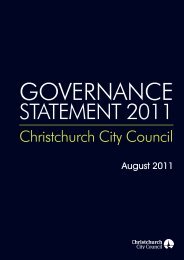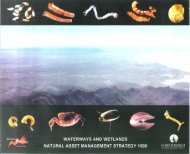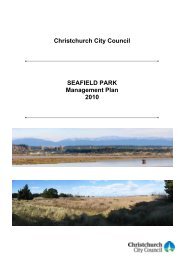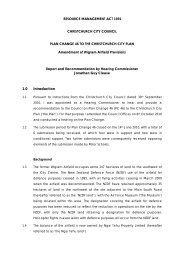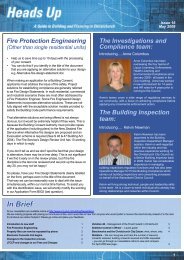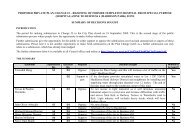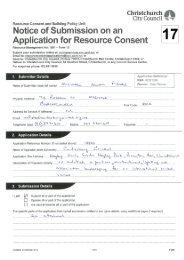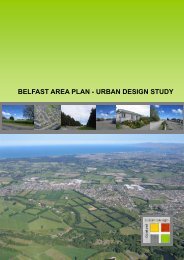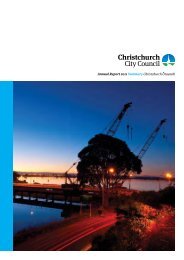Annual Report 2010 - Christchurch City Council
Annual Report 2010 - Christchurch City Council
Annual Report 2010 - Christchurch City Council
You also want an ePaper? Increase the reach of your titles
YUMPU automatically turns print PDFs into web optimized ePapers that Google loves.
p154. <strong>Annual</strong> <strong>Report</strong><br />
<strong>Christchurch</strong> Otautahi<br />
<strong>2010</strong><br />
Financial statements<br />
Statement of<br />
accounting policies<br />
(continued)<br />
Notes to financial statements<br />
1. Statement of accounting policies (continued)<br />
Critical judgements, estimates and assumptions in<br />
applying <strong>Council</strong>’s accounting policies<br />
Preparing financial statements to conform with NZ IFRS requires<br />
management to make judgements, estimates and assumptions that<br />
affect the application of policies and reported amounts of assets<br />
and liabilities, income and expenses. The estimates and associated<br />
assumptions have been based on historical experience and other<br />
factors that are believed to be reasonable under the circumstances.<br />
These estimates and assumptions have formed the basis for making<br />
judgements about the carrying values of assets and liabilities,<br />
where these are not readily apparent from other sources. Actual<br />
results may differ from these estimates.<br />
Estimates and underlying assumptions are regularly reviewed.<br />
Any change to estimates is recognised in the period if the change<br />
affects only that period, or into future periods if it also affects<br />
future periods.<br />
In the process of applying these accounting policies, management<br />
has made the following judgements, estimates and assumptions<br />
that have had the most significant impact on the amounts<br />
recognised in these financial statements:<br />
• The physical deterioration and condition of an asset. This is<br />
particularly so for those which are not visible, for example<br />
stormwater, wastewater and water supply pipes that are<br />
underground. The risk is minimised by <strong>Council</strong> performing a<br />
combination of physical assessments and condition modelling<br />
of underground assets, estimating any obsolescence or surplus<br />
capacity of an asset and estimating the remaining useful lives<br />
over which the asset will be depreciated. These estimates can<br />
be impacted by the local conditions, for example weather<br />
patterns and traffic growth. If useful lives do not reflect the<br />
actual consumption of the benefits of the asset, then <strong>Council</strong><br />
could be over or underestimating the annual depreciation<br />
charge recognised as an expense through the profit and loss. To<br />
minimise this risk <strong>Council</strong>’s infrastructural asset useful lives<br />
have been determined with reference to the NZ Infrastructural<br />
Asset Valuation and Depreciation Guidelines published by the<br />
National Asset Management Steering Group, and have been<br />
adjusted for local conditions and past experience. Finally,<br />
<strong>Council</strong>’s assets are also periodically revalued by experienced<br />
independent valuers who provide assurance that <strong>Council</strong>’s<br />
useful life estimates are valid.<br />
• The valuation of the <strong>Council</strong>’s investments in subsidiary and<br />
associated companies at fair value has a material impact on the<br />
amounts recognised in these financial statements and involves<br />
a significant amount of judgement. Independent valuers are<br />
commissioned to perform these valuations on a periodic basis,<br />
at intervals sufficient to ensure that the fair value of these<br />
investments does not differ materially from their carrying value.<br />
• The non-current provisions note discloses an analysis of<br />
<strong>Council</strong>’s exposure in relation to estimates and uncertainties<br />
surrounding the landfill aftercare and weathertight homes<br />
provisions.<br />
• Management are required to exercise judgement in calculating<br />
provisions for doubtful debts, assessing the level of<br />
unrecoverable work in progress and calculating provisions for<br />
employee benefits.<br />
• Management of subsidiary companies determine useful lives<br />
for particular assets. In making this assessment, they make<br />
judgements about the expected length of service potential of the<br />
asset, the likelihood of the asset becoming obsolete as a result<br />
of technological advances and the likelihood of the company<br />
ceasing to use the asset in its business operations.<br />
• Management of the subsidiary companies assess whether<br />
individual assets or groupings of related assets (which generate<br />
cash flows co-dependently) are impaired by estimating the<br />
future cash flows that those assets are expected to generate.<br />
Assumptions such as rates of expected revenue growth or<br />
decline, expected future margins and the selection of an<br />
appropriate discount rate for discounting future cash flows are<br />
required.<br />
In addition to the above factors, the following areas specific to<br />
individual companies within the group require critical judgement<br />
estimates and assumptions.<br />
• Orion New Zealand Ltd’s electricity distribution network<br />
comprises large numbers of relatively minor individual network<br />
asset components which are replaced on a regular basis. The<br />
costs of recording and tracking such components substantially<br />
outweigh the benefits of doing so. Management use estimates<br />
of the quantities and carrying values of these components. Any<br />
errors in the estimates are corrected at the next asset revaluation<br />
and are not considered to be material.<br />
• Orion New Zealand Ltd invoices its customers (predominantly<br />
electricity retailers) monthly for electricity delivery services on<br />
the basis of an estimation of usage, adjusted for the later, more<br />
accurate data available from the electricity wholesale market and<br />
certain metering data from electricity retailers. Management<br />
makes an allowance in revenue and in current assets/liabilities<br />
for any amounts which are estimated to be under/over charged<br />
during the reporting period. However, as final wash-up metering<br />
data is not available for in excess of twelve months, it is possible<br />
that the final amounts payable or receivable may vary from that<br />
calculated.<br />
• Orion New Zealand Ltd enters into arrangements with customers<br />
to purchase new network assets at below current replacement<br />
costs. Management estimate the difference between cash costs<br />
and the replacement costs of these assets, and the differences are<br />
reported within revenue. Any errors in estimating the carrying<br />
values of these assets are corrected at the next asset valuation<br />
date.<br />
• Management of <strong>Christchurch</strong> International Airport Ltd use<br />
judgement in identifying which components of property, plant<br />
and equipment are to be reclassified as investment property. The<br />
main deciding factor for this classification is that the property is<br />
not used for aircraft-related activities.<br />
• Management of <strong>Christchurch</strong> International Airport Ltd have<br />
estimated an impairment charge in respect of the ongoing value<br />
of capitalised expenditure on the integrated terminal project,<br />
due to the evolving nature of the design. Reviews by quantity<br />
surveyors and project managers were used in making the<br />
impairment assessment.<br />
• Management of Lyttelton Port Company Ltd are required to<br />
exercise judgement in determining the carrying value of land,<br />
buildings and harbour structures, amortisation of intangible<br />
assets such as resource consents, easements and software, and<br />
the quantification of contingent liabilities.





